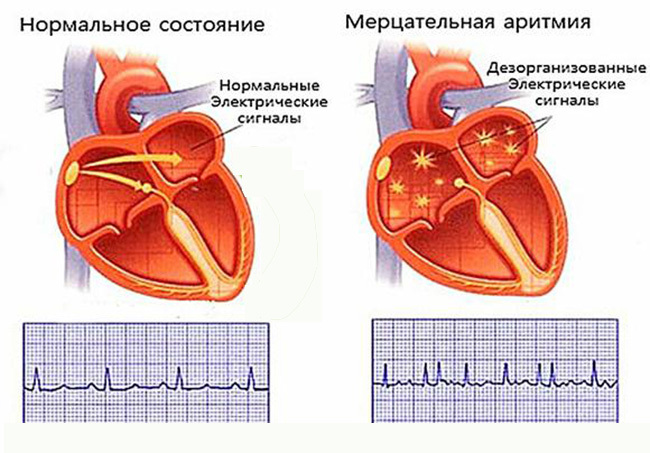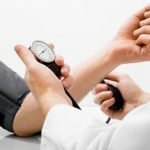Feeling of fading in the chest or, conversely, a sudden increase in heartbeat is familiar to almost every woman. But not everyone knows that this is how arrhythmia manifests itself. Such conditions can be functional or be a consequence of a serious illness. What are the causes of the occurrence of pathological phenomena? Why there is an arrhythmia at monthly and on a background of a premenstrual syndrome? Is it dangerous and how to get rid of the problem?
Causes of Rhythm Change
Arrhythmia arises by the type of acceleration or deceleration - tachycardia and bradycardia, respectively. Also single or group extrasystoles are given - periodic cardiac contractions that do not "fit" into the overall rhythm. They can be of both atrial and ventricular origin.
Including a permanent form of cardiac dysfunction - atrial fibrillation. In this case, each cardiac fiber is reduced in its mode.
Periodic tachycardia or bradycardia, as well as extrasystoles can be a consequence of hormonal or other functional disorders, but atrial fibrillation always speaks of some serious pathology.

Vegeto-vascular dystonia
The vegetative nervous system also regulates the work of the heart and its contractions. With VSD, all kinds of arrhythmia can occur. Moreover, along with unpleasant sensations in the chest, a woman will be disturbed by pressure changes, dizziness, reddening or blushing of the complexion and other signs.

Vegeto-vascular crises occur more frequently on the background of premenstrual syndrome and during menstruation. Therefore, arrhythmias are recorded at this time. This is primarily due to the change in the hormonal background these days.
Thyroid Disease
Both insufficiency and hyperthyroidism of the thyroid gland can give a rhythm disturbance. And for a hypothyrosis bradycardia is characteristic, when the heart rate decreases to 60 and below, and for a hyperthyroidism - a tachycardia, at a heart rate more than 90 beats / mines. This is due to the fact that the thyroid hormones have a direct effect on the sympathetic and parasympathetic nerve plexuses that regulate the work of the heart. On the eve and during menstruation, these phenomena can become more frequent.
Other endocrine pathology
All organs of endocrine secretion affect the functioning of the heart in varying degrees. For example, with the pathology of the adrenal glands, arterial pressure may increase, in which arrhythmias occur.
Cardiovascular pathology
Normally, the heart rhythm is generated in one place, after which the impulse is transmitted further. This leads to a gradual reduction in the atria and ventricles. In heart defects, congenital or acquired, impulse formation may be impaired, leading to arrhythmias. The frequency and duration of them depends on the severity of the defects in the structure.
Psycho-emotional factors
Many women are emotionally labile. And their psychoemotional state can cause arrhythmias. And more often it is tachycardia and various extrasystoles. Arrhythmia can not appear immediately in a moment of shock, but after a while. In such situations, the use of various sedative herbs, syrups, vitamins significantly improves the woman's well-being.
Violation of electrolyte balance
In the imbalance of potassium, calcium, magnesium, the work of the heart muscle can be disrupted. No other symptoms, except for arrhythmias and associated manifestations, a woman may not feel. More often, this occurs when the medication is not absorbed( eg, diuretics), as well as kidney pathologies, diabetes mellitus, and the like.
Premenstrual syndrome

Menopausal manifestations of
As never before, women often report cardiac dysfunction precisely during the onset of menopause and some time after its onset. This is due to the fact that the sex hormones perform a kind of protective function for the body for the development of atherosclerotic changes in the blood vessels, including the heart, and also prevent the impairment of the conductivity of the electrical impulse in it. And with their deficiency, the pathology manifests itself.
Arrhythmia attacks most often coincide with tides or follow immediately after them. Competent correction of climacteric disorders, including hormone replacement therapy, neutralizes all manifestations of the disease.
These are the most common reasons why women have an arrhythmia before or during menstruation. A true problem can be established only by a specialist after a comprehensive survey.
For reasons of arrhythmia, see the video:
Examinations for pathology
The first thing you need to do to identify arrhythmia is to perform an electrocardiogram( ECG). But episodic cases and single extrasystoles in this way can not be caught. Then Holter monitoring comes to the rescue, in which the ECG is recorded within 24 hours. After that, the results are analyzed. So you can identify even a single daily rhythm disturbances, count the number and subsequently assign adequate therapy.
But it is not enough to establish the presence of arrhythmias, it is important to establish their true cause. It is from this that the most effective treatment can be constructed. For this it is necessary to undergo a complex of examinations, which is determined by the doctor. Most often this includes:
- blood for thyroid hormones, ultrasound examination of this organ for the detection of pathological foci of secretion,
- developed biochemical blood test with electrolytes,
- lipid profile of blood,
- ultrasound examination of internal organs, if necessary - CT or MRI,
- definition of ECG during exercise, veloergometry.
Is it so dangerous arrhythmia
Any suspicions of arrhythmia can not be ignored. After all, such violations can lead to serious, sometimes life-threatening consequences.
First, the constant episodes of arrhythmia will lead to a deterioration in the general well-being of a woman. Headaches, weakness, lethargy, decreased efficiency, dizziness, discomfort and unpleasant sensations behind the sternum and many other symptoms become permanent companions. Due to arrhythmias, blood supply to organs and tissues is impaired, and this leads to disruption of their work. This can contribute to the development of mental disorders up to dementia.

In addition, if violations occur due to a change in the functioning of an organ, this soon leads to its depletion. Also, for arrhythmia can hide the tumors of the thyroid gland, adrenal glands and other organs.
We recommend that you read an article on menstrual pressure. From it you will learn about the impact of the work of the reproductive system of a woman on blood pressure, as well as the causes of high and low rates.
How to get rid of the problem
Adequate and most effective treatment can be prescribed only by a specialist, in some cases, enough soothing fees and infusions, and in others, surgical treatment is necessary.
Medications
There are a lot of tools to restore the normal rhythm of the heart. However, they are effective only if the cause is not hidden in the pathology of other organs.
In case of thyroid dysfunction, restoring the normal level of its hormones in most cases leads to the disappearance of arrhythmia.
Various dietary supplements, homeopathic remedies, sex hormones are indicated for the treatment of premenstrual and climacteric syndromes. As soon as their manifestations decrease, the signs of arrhythmia and all the associated symptoms go away.
Surgical procedures
Only by indications and when establishing the true cause, surgical treatment can be performed. The most common methods are ablation of the nerve pathways and the establishment of an artificial pacemaker. Both methods can be carried out repeatedly, as necessary.
Lifestyle
It is important to observe an active lifestyle, the foundations of a correct and balanced diet.
Various relaxation techniques also help, for example, yoga practice, etc. The calm perception of all the surrounding information, the preservation of peace of mind and balance in any situation helps to maintain health, prevent the development of pathology.
Arrhythmia is a serious disorder in the work of the heart. If her first symptoms appear, or even only if she is suspected, seek medical attention. Only a specialist can establish the true cause and prescribe the right treatment. Often women can note that there is an arrhythmia during menstruation or on the eve of them. Especially similar is typical for premenstrual syndrome and climacteric disorders. Correction of these disorders leads to the disappearance of arrhythmia.

